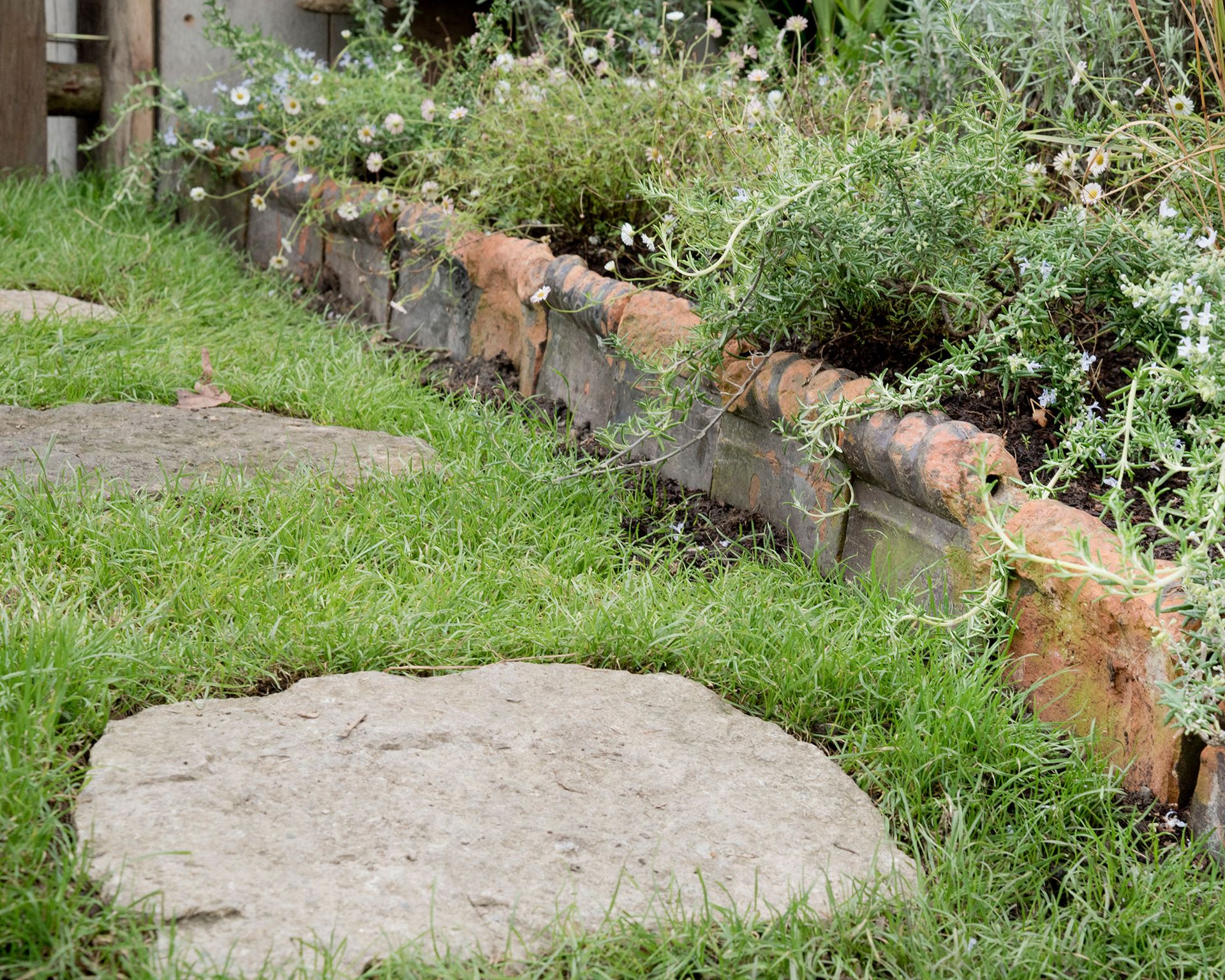These cheap DIY garden path ideas prove you don’t have to spend a fortune to make an impact on your outdoor space
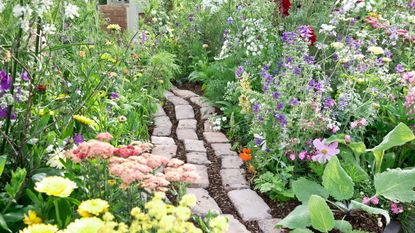
When budgets are tight, cheap DIY garden path ideas are a great solution if you’re looking to add a new feature to your plot without spending a fortune.
Every garden needs a path, so you can move easily around your outdoor space, for practical purposes such as tending plants, flowers and homegrown produce, and as a vital design feature to help to delineate sections of outdoor space – into planting, seating and relaxing areas, for example.
However, laying a path can be a significant investment costing thousands of dollars, especially if you go for premium materials. But the good thing about making a path with less expensive materials is that once you’ve done the hard work – deciding where it is to go, how long and how wide it needs to be and what features it will connect together – you can always upgrade later on if you need to.
You might choose not to; there’s such a huge choice of materials for a cheap DIY garden path, from gravel, bark and reclaimed bricks and stones, to pebbles and decking boards, you may decide to make your DIY creation a permanent fixture.
Also, all of these cheap garden ideas can be undertaken by anyone with a basic grasp of DIY, so opting for one of these will save money on labor costs too.
SAVE MONEY WITH THESE CHEAP DIY GARDEN PATH IDEAS
Give definition to your outdoor space with our favorite garden path ideas that can be completed on a DIY basis. Gravel, timber and reclaimed bricks are amongst the strong design statements that don’t cost the earth and are easy to achieve.
1. GET THE COASTAL LOOK WITH A CHEAP DECKING BOARD PATH

Decking boards can be used to make an inexpensive but effective path
If you’re after that super-smart coastal vibe for your budget backyard ideas, consider using timber decking boards or planks, laying them horizontally to create a cheap DIY garden path. If you want to add interest, you can edge the decking or planks with lines of gravel or pebbles.
This boardwalk style of path can also be super practical; a wheelbarrow will have no problem navigating a decking path.
‘Decking boards are easy to lay and are a cost-effective solution to creating a path in your outdoor space,’ says Rowan Cripps, owner of landscaping company Infinite Paving(opens in new tab). ‘If you choose a lighter wood, you also bring some light to the garden. Also, hardwood decking is a sturdy material which will withstand a lot of hammer.’
2. TEAM PAVING WITH INEXPENSIVE PEBBLES
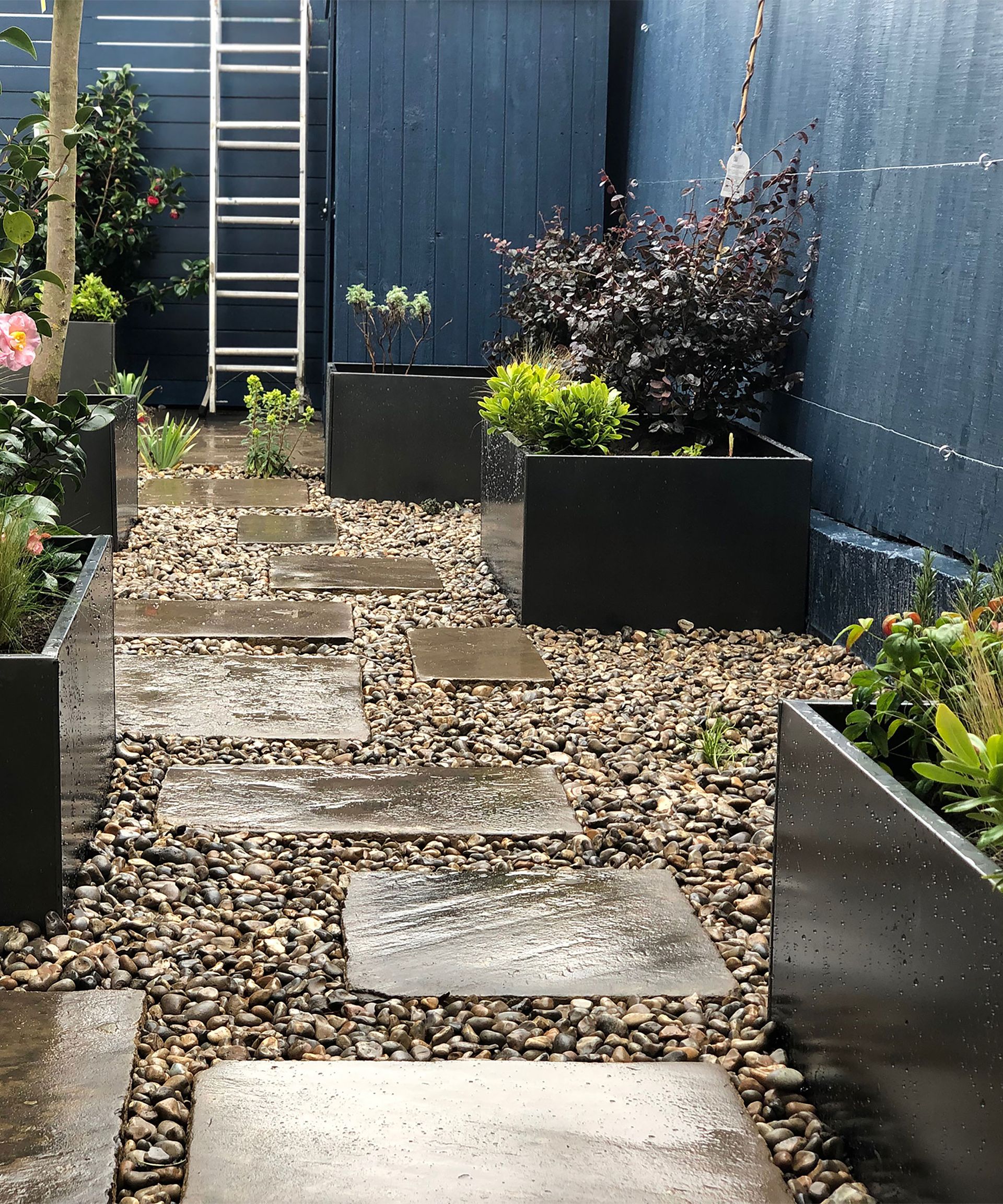
Pebbles can add texture and interest to a basic path
Landscaping with pebbles can be a smart way to cut costs, creating a fascinating DIY garden path that’s rich in texture and color. This choice will suit both a rustic, traditional garden as well as a streamlined contemporary design scheme.
The beauty of pebbles is that they are entirely natural and always come mixed in various shades of earth browns, soft grays and neturals. So, if you’ve a lot of competing visual elements in the background of your yard, a DIY pebble path will tone in nicely with surrounding features and buildings.
3. REPURPOSE RECLAIMED BRICKS TO CUT DOWN ON COSTS

Creating a DIY path with bricks pavers like this is perfect for a rustic garden scheme
Using reclaimed bricks for a cheap DIY garden path will add character to your space as well as allowing you to tie in the new walkway with other parts of the exterior of your house. To create a coherent overall look, it can be helpful to ensure the new path will reflect the surrounding brickwork.
Not only is opting for reclaimed materials a great way to save money in the garden, but whether you source them from a reclamation company or utilize materials left over from another project, it’s also good for environmental credentials too.
‘Using reclaimed bricks that are spare from another home project is not only cost effective but it’s also a good eco landscaping idea as it’s a form of unprocessed recycling,’ says garden designer Nathan Gamba at Protea Gardens(opens in new tab). ‘It reduces the need to produce more materials and saves on waste.’
Choosing more rustic looking reclaimed bricks or pavers like the ones pictured is ideal if you’re hoping to create an attractive cottage garden path in your plot too.
4. GO FOR A DIY GRAVEL PATH

Gravel can be easy to shape into curves
Landscaping with gravel is one of the cheapest and quickest ways to create a DIY walkway in a garden. Gravel is also very versatile. You can choose from a huge range of colors including white, buff, gray, mixed and soft red/pink. Even cheaper, especially if bought in bulk, is crushed stone such as limestone.
Gravel is very versatile; warm-colored gravel with yellow/orange tones offers a Mediterranean gravel garden feel, while white will be more contemporary. Also under the heading of ‘gravel’ comes reclaimed materials such as crushed shells, which are perfect for a maritime garden.
‘Gravel is a great option financially and is super simple to construct,’ says Rowan Cripps. ‘Whether you opt for a meandering path or carefully curated layouts, gravel makes maintaining a garden easy and low maintenance.’
Another bonus of using gravel for your cheap DIY garden path ideas is that it’s easy to refresh it; when it starts looking a bit battered, simply add more gravel.
5. OPT FOR A SIMPLE PLANTED PATHWAY

Plants can make a pretty alternative to hard landscaping materials
You can make a cheap DIY garden path without relying too much on expensive landscaping materials. Instead use fast-growing and fragrant ground cover plants to fill in the bulk of the path, saving outlay on paving stones, gravel and other costly aggregates.
Creeping thyme or camomile are good path plants for sunnier spots, whilst delicate baby tears (Soleirolia soleirolii) works best in a shady area. Blue star creeper (Laurentia fluviatilis) with masses of pale blue, star-shape flowers in spring and early summer, or golden/grey Creeping Jenny (Lysimachia nummularia), also known as moneywort due to its coin-shaped leaves, add color. Most planted paths are suitable for light foot traffic only, but look very pretty all the same.
6. USE BUDGET-FRIENDLY LANDSCAPING BARK

Bark chippings work well with a romantic planting scheme
Excellent material choices for a budget-friendly DIY garden path include wood chips, shredded bark or crushed cocoa shells. Chippings or landscaping bark are a good option if you want to use natural materials. It’s easy to lay too, just tip up the bag and rake into place.
And chippings are even cheaper than gravel, although it’s important to lay a weed barrier landscape fabric (available from Amazon)(opens in new tab) beneath a chipping path to prevent weeds from working through. If you change your mind about your bark path, you can use the chippings for mulching your flower beds.
However, there are a few dos and don’ts of designing a path with these materials. Chippings are less suitable than other materials for a damp or poor-draining area of the garden as they will become slimy and even dangerous.
You will also need to rejuvenate a path like this every couple of years as the organic material will degrade. Chippings may not be the best option if you have pets or children as heavy use (or digging) will scatter the chippings all over the garden.
And you do need to find a way to contain the chippings or bark with an edging, says BBC Garden Rescue’s presenter and garden designer Lee Burkhill, owner of Garden Ninja(opens in new tab). ‘The best way to contain bark chippings is to use metal garden edging. It’s super cost effective and really easy to install yourself. It helps define the path and can prevent animals from kicking the chippings about too much.’
7. STEP FORWARD WITH A DIY STEPPING STONE DESIGN
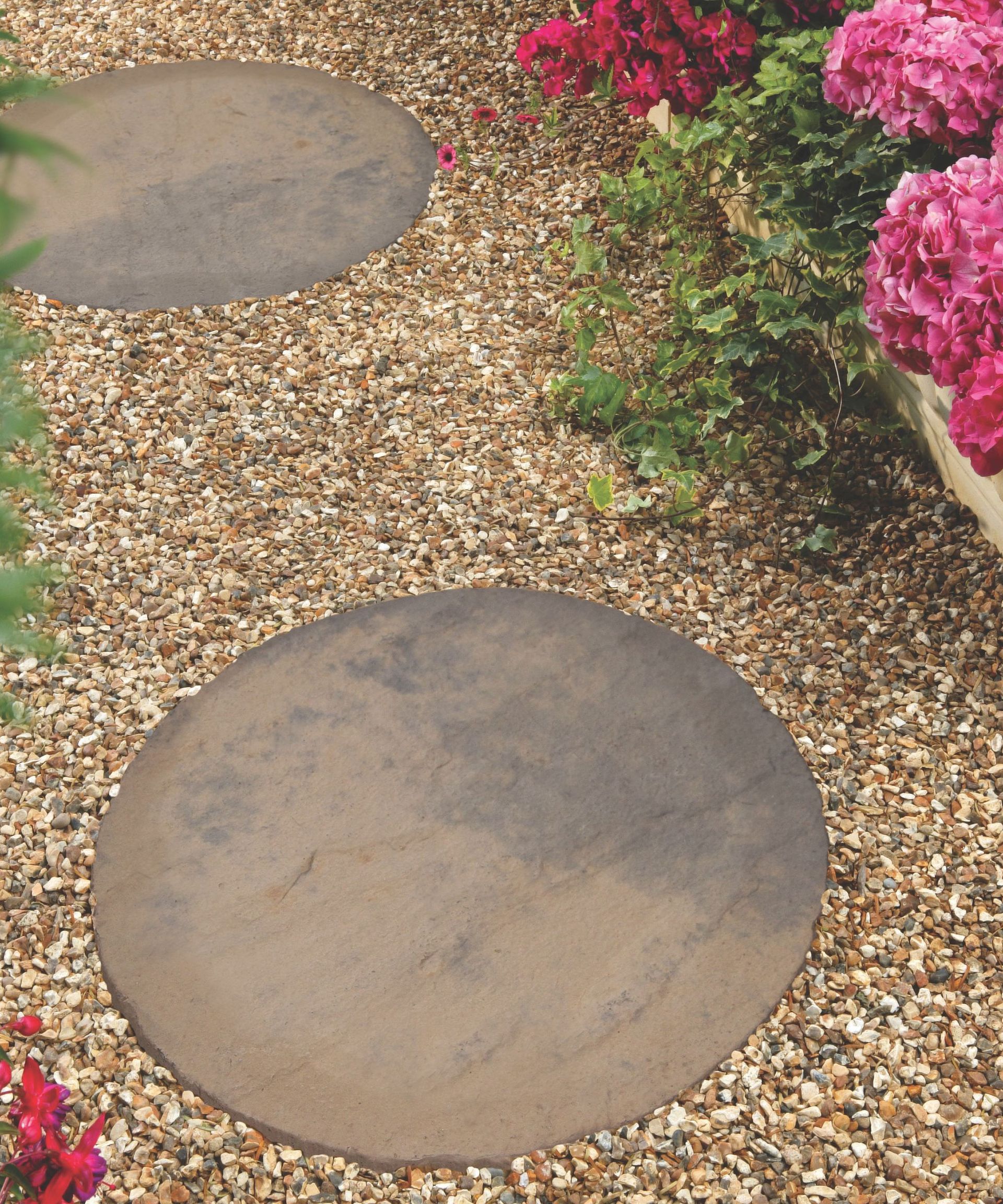
York brown stepping stone from B&Q(opens in new tab)
Informal stepping stone ideas will give a relaxed look to any garden. One of the best things is that their circular shape means they feel very natural when used as a cheap DIY garden path.
Stepping stones can be used easily for transition between different areas of an outdoor space. As they are an understated addition to a garden, they don’t have to impose too heavily on the rest of the design.
‘Circular paving stones add character and charm to every space, and are great for smaller gardens as the path doesn’t need to take up too much room,’ says Rowan Cripps.
They are an especially good choice if you want to create an easy route across a muddy area or need to protect your lawn from people walking over it. Plus, as learning how to lay stepping stones is relatively straightforward, this is a quick and easy way to get your new DIY path in place.
8. SORT IT WITH INEXPENSIVE RAILROAD TIES

Sleepers from B&Q(opens in new tab)
You can use sleepers or railroad ties – either short timber sleeper lengths or outdoor porcelain tiles designed to look like wood – in the same informal way as circular stepping stones. Just lay them horizontally into turf for a cheap DIY garden path.
However, it’s also possible to create a more formal path with sleepers by surrounding them with gravel, chippings or pebbles and encasing the path with a hard border, such as a concrete edging.
The material surrounding a sleeper path can be in either a complementary or contrasting color. Whatever your choice, landscaping with timbers in this way provides a strong design feature in a garden and it doesn’t have to cost a fortune. It’s a good way to lead into a hidden corner of garden; the horizonal placing of each sleeper acts like a ladder leading forward.
9. SELECT COLORFUL SLATE FOR A BOLD DIY PATH

When laid in a path, slate chippings work like gravel or pebbles or cobblestones. You can also buy slate paving stones, but these are a more expensive option so less suitable for cheap DIY garden path ideas.
Slate doesn’t have to be one shade of gray either; it can be dark gray, soft gray, plum or black. ‘Ideally, when choosing a slate color for a path, look at the surrounding area and how it can complement colors already in the garden as well as the exterior of the house,’ says Nathan Gamba. ‘Also consider the look you are trying to create – strong contrast or “disappearing” complementary shades.’
10. LAY A TILED PATH YOURSELF TO SAVE ON LABOR COSTS
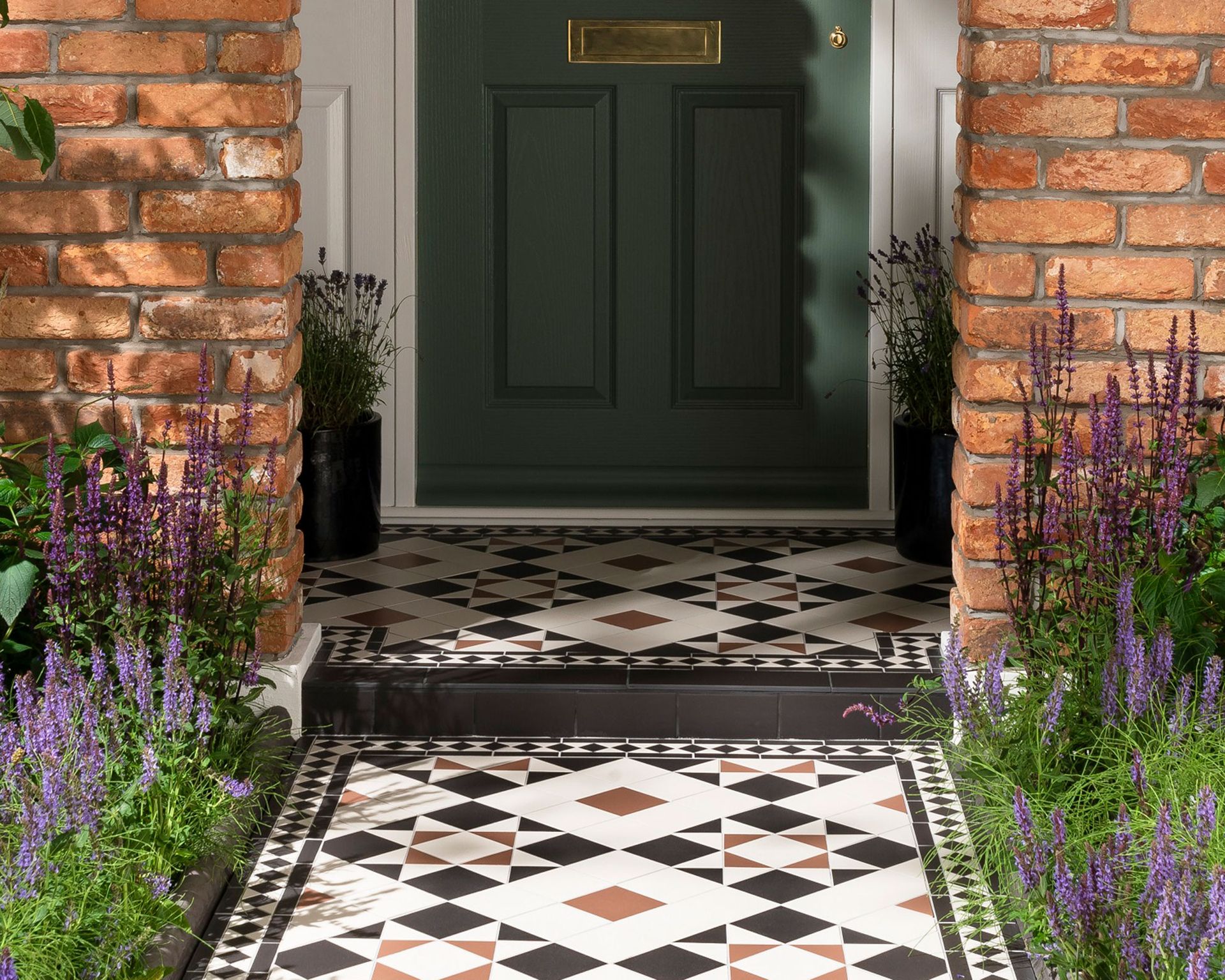
Victorian Flooring from Topps Tiles(opens in new tab)
Making a cheap DIY garden path in a front garden should focus on visual impact and curb appeal. If you live in a period property, nothing beats a beautifully tiled path leading to the front door.
But original and reproduction porcelain tiles can break the bank, and installing them can be very costly if you have to hire someone to do it for you. However, if you’re good at DIY and want to create this timeless look for less, you could focus your attention on a smaller area, such as the step and the area immediately in front of the door.
This will cut costs and allow you to fill out the rest of the path with a less-expensive material, such as gravel. Choose a gravel color to tone in neatly with the tiling, then make sure you add some good path lighting along the length of your walkway so you get the full benefit of the statement pattern during the day and after dark.
WHAT’S THE CHEAPEST MATERIAL FOR A DIY GARDEN PATH?
Two of the cheapest ways to lay a DIY garden path are to use gravel or bark, because you can buy it in bulk from a garden center, DIY store or online, and have it delivered to your door. However, if you want to lay a path across grass, an even cheaper – and easier – option is to put down stepping stones.
You only have to dig two to three inches into the ground (most stepping stones are around two inches deep), then pop the stepping stones into place. Stepping stones are a good choice for sloping gardens as you won’t have to level them up. Also, you won’t have to think about problems with garden drainage, or leaves and other debris accumulating at the bottom of a sloping path.
‘If you want to opt for a DIY cottage garden-style path, you could consider stepping stones with colorful planting to each side and ground cover plants in between each slab,’ says Johanna Elvidge, head of domestic design at Marshalls(opens in new tab). ‘If you like a natural look, consider a concrete stepping stone with a wood-effect style.’

Bark is one of the most cost-effective materials for a DIY path
HOW CAN I MAKE A CHEAP DIY GARDEN PATH LOOK MORE EXPENSIVE?
Cheap DIY garden path ideas can look a million dollars if you choose a crisp edging to define an exterior edge. This is also a practical bonus. If you pick gravel or bark for your DIY path design, you will need some kind of edging to contain everything.
For cheap garden edging ideas, your best option is plastic landscape edging, available at Amazon(opens in new tab). Products such as this 20ft garden kit with 18 stakes at Amazon(opens in new tab) come on a roll and simply fit into shape.
Steel or aluminium edging gives a sharp and defined look and is good for a modern garden design. Concrete pavers, new bricks or stone paving stones are more expensive, but if you choose a cheaper material for the path itself, these ideas will add a touch of class without going to the expense of laying a full path in a high-cost material.
If the path is straight, landscaping timbers can also be used to create a pleasing edge that will weather and silver beautifully in time.
